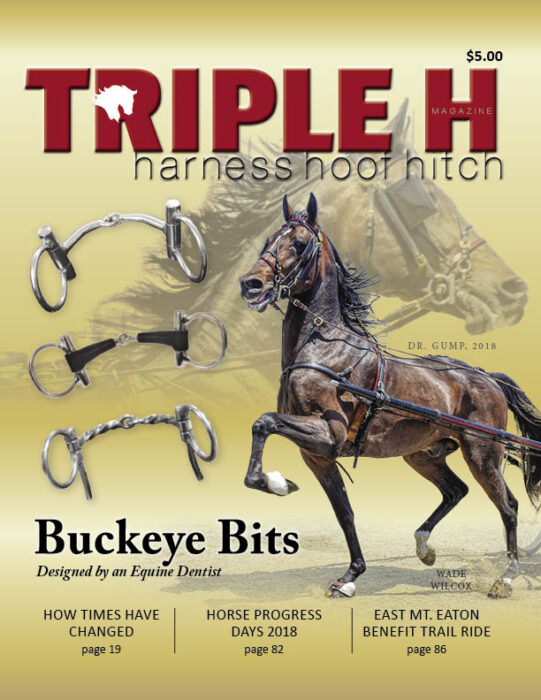Several years ago, a new bit maker came on the scene in Wayne County, Ohio. Melvin Miller of Buckeye Bits now has a growing business in equine dentistry, as well as designing high quality bits that will keep a driving horse happy and comfortable.
Dreaming Of Horses, Not Cows
As a boy, Melvin Miller started out milking cows on his father’s dairy farm. Though his father was not a professional horseman, he still had an eye for a nice driving horse. “Dad didn’t deal horses, but had a weak heart for a good horse,” he says.
While still living at home, Melvin bought, broke and sold ponies. It was good practice for what was to come. At the age of 20, he purchased his first Standardbred to fit for sale. Since then, he has had at least four driving horses in his string.
When buying a horse, Melvin’s first priority was always to get the horse’s teeth checked first. That led to a second career in equine dentistry.
Apprenticing With The Best
In 2016, while working on roofing and finishing crews, Melvin began traveling with Carson Haignere, a well-known equine dentist from Mount Vernon, Ohio. With 25 years of experience, Mr. Haignere was a good teacher. Working with him was good experience for the young dentist.
Several years ago, Melvin started his own full time equine dentistry business. At the Equine Expo in Mount Hope, he met up with Dale Jeffery who was in town to speak at a seminar. The owner of Worldwide Equine Dentistry School, Dale became a mentor and to this day is Melvin’s home base for questions and tips.
Currently, Melvin is now treating 1,400 to 1,500 horses per year, centering his dentistry practice in the Northeastern Ohio Amish communities.
A Horse’s Teeth, Body and Mind Are Tied Together
Melvin’s philosophy is that a horse’s teeth are central to his health in a variety of ways. Most often, horse owners notice problems with chewing and weight loss before thinking of floating teeth. However, there is more to dental health than a horse’s physical condition.
If an owner notices a horse shaking his head while driving or perhaps cocking his head to the side, it’s a good sign his mouth is uncomfortable. The horse is naturally making his own adjustments to relieve pain, but that can place strain on the tempomandibular joint, atlas, neck vertebrae and more.
The horse may not be unsound, but his mind will be concentrating on relieving pain, not on the driver’s cues. This is a danger to both horse and driver.
A Good Equine Dentistry Program
Before opening the mouth, Melvin feels the horse’s jaw for any sharp points on the outer edge of the molars. After that, he opens the mouth and checks the molars in the back of jaw. If he finds any high spots, sharpness or unevenness, he rasps off the teeth so they are smooth.
As mentioned before, teeth issues can be connected to a horse’s neck and shoulders as well. That is why Melvin recommends that dental treatments should go hand in hand with chiropractic adjustments. Both should be a part of your horse’s maintenance schedule.
With younger horses ages two to three years old, it’s important to have their teeth checked every six months. Their teeth are growing fast at this age and are still soft. Also, young horses beginning training should have their wolf teeth pulled before a bit goes into their mouths. Intact wolf teeth will interfere with the action of the bit. If left untreated, the colt may not respect the bit, introducing habits that can be hard to break. Ideally, the bit should rest on the bars right next to the first molar.
For horses ages four and up, it’s recommended to have the horse’s teeth floated once a year. The exception may be an aged horse that consistently wears his teeth unevenly or is a hard keeper.
When asked about his worst case, Melvin tells the story of a “20 year old horse that had a lower molar so long that it grew into the top of the mouth. I couldn’t float it and had to clip it off. That’s the first time I called Dale Jeffery for advice. It was actually a good thing, because we became good friends after that.”
The biggest problem Melvin sees are “horses that either have never had their teeth floated or not floated properly. When a dentist is not properly trained or doesn’t have the correct tools, the back molars are often untouched.”
Designing Bits
In the summer of 2018, Robert Hershberger of Dublin Valley approached Melvin about designing bits. “Robert believed this was a natural progression from my dentistry practice,” he says. By the fall of that year, Buckeye Bits had six bits designed, manufactured and ready to sell.
The first bit designed was the #12 Comfort Bit, which remains a best seller. The mouthpiece has a unique bend to shape the horse’s mouth and avoid pinching.
Each bit is made of hardened stainless steel with continuous posts to make them extra tough. Each part of the bit is made by an Amish craftsman in Ohio, and has a lifetime guarantee on breaking. “Imported bits can actually pull apart if the horse pulls and breaks the posts. Before I started with bits, it happened to me one time. It’s actually a safety issue. If a bit breaks, where will you end up? Our bits can be used for many years and by many horses,” he says.
After the first bits were manufactured, Melvin turned his attention to specialty or corrective bits. Clients brought him in to examine problem horses and design a bit to help that horse.
The process of designing bits is neither simple nor easy. Though it takes about eight weeks from design to a prototype, there is much testing to be done before a bit is labeled as an official Buckeye Bit. Melvin tests the bits himself and sends them to a selected circle of clients for feedback. “Without the ideas of customers, this would not be possible,” says Melvin. Changes are made until the bit functions perfectly.
Innovating With Leather
Client feedback is exactly how the leather-bound bit was designed. After struggling with a sore-mouthed horse that pulled hard on the lines, a customer asked Melvin for help. Buckeye Bit’s newest leather bound bits are tailored for such horses.
The #13 Comfort Leather is the leather version of the popular #12 Comfort Bit. It’s been wildly popular and has become the bit of choice for several professional horsemen. It’s used as both a corrective and regular driving bit. Melvin says, “Horses that really took a hard hold now back off and drive more relaxed.”
Made with tough bullhide leather, each bit is wrapped and expertly stitched with waterproof thread at an Amish shop in Holmes County. Most importantly, the leather is tucked around the posts – this prevents the leather from shrinking, sliding in and irritating the horse.
Melvin has some basic care tips for leather bound bits. “Once a week, we recommend that you coat the leather in a food grade vegetable oil. This will keep the leather from drying out.”
The Experts Are Saying
Jr. Fisher of Lan-Chester Equine in Honeybrook, Pennsylvania
“I fit horses for sale and specialize in Standardbreds. I like the #13 Leather Comfort and #20 Pretzel Bit. The Pretzel Bit is great for getting aggressive horses to respond. Buckeye Bits are made to last, look classy and they offer a variety of bits for sensitive to hard-mouthed horses. Melvin is very open-minded and is willing to make changes if needed. His customer service is great!”
Lester Shrock, Middlefield, Ohio
“We fit driving horses and raise Standardbreds for racing. The #13 Leather Comfort Bit is what we like for horses that have sensitive mouths or have sores from pulling on the lines. When horses have relief from the sores, they no longer pull so hard. We continue to use the leather bit after the sores have healed. It’s good for correction or every day use.”
A Complete Line
Now with a line of 14 bits, Buckeye Bits has choices in stainless steel, sweet iron or copper inlay in 4 ¾ and 5 inch sizes. There are bits for training, correction and even horses that flip their tongue over the bit. The three newest bits are all leather bound, including the #33, a tongue relief bit, the #37, a straight bar bit and the #10 Comfort Bit with half cheek.
Buckeye Bits is always improving and adding to their lineup of bits. The current line of bits is tailored for light driving horses, but a line of pony bits is planned for the future. “Kids are usually the ones driving ponies, and keeping those ponies happy is also about keeping kids safe,” says Melvin. Draft bits have been requested and will be coming up as well. If you have a problem horse, feel free to contact Melvin for advice or request a new design.
You can find Buckeye Bits at a variety of dealers, but they can also be shipped if needed. Dealerships are available in areas that are not currently serviced. Melvin is also available at trade shows such as the Mount Hope Equine Expo, Horse Progress Days and the Memorial Trotting Sale. Contact Buckeye Bits at VM 330-600-7133.

